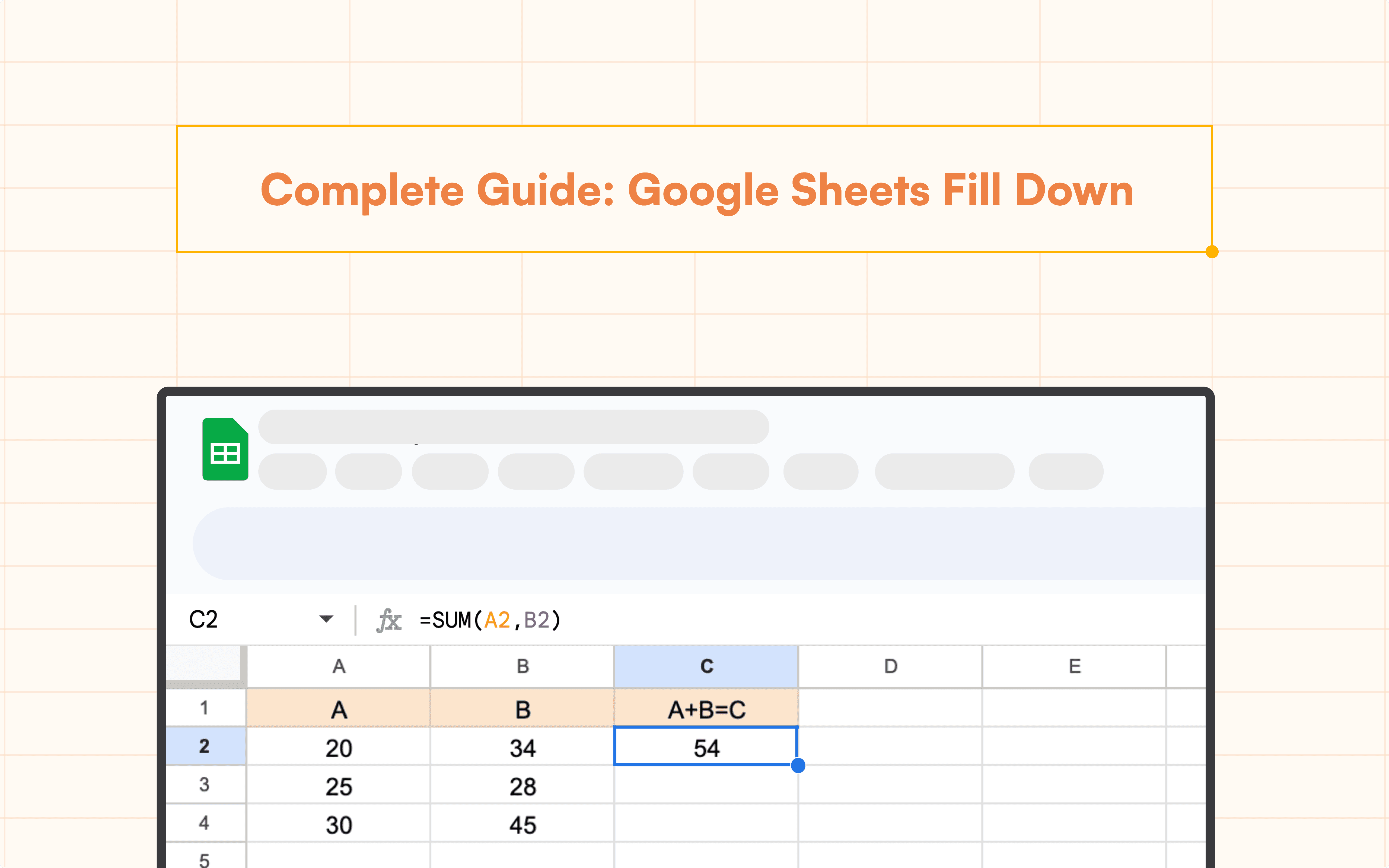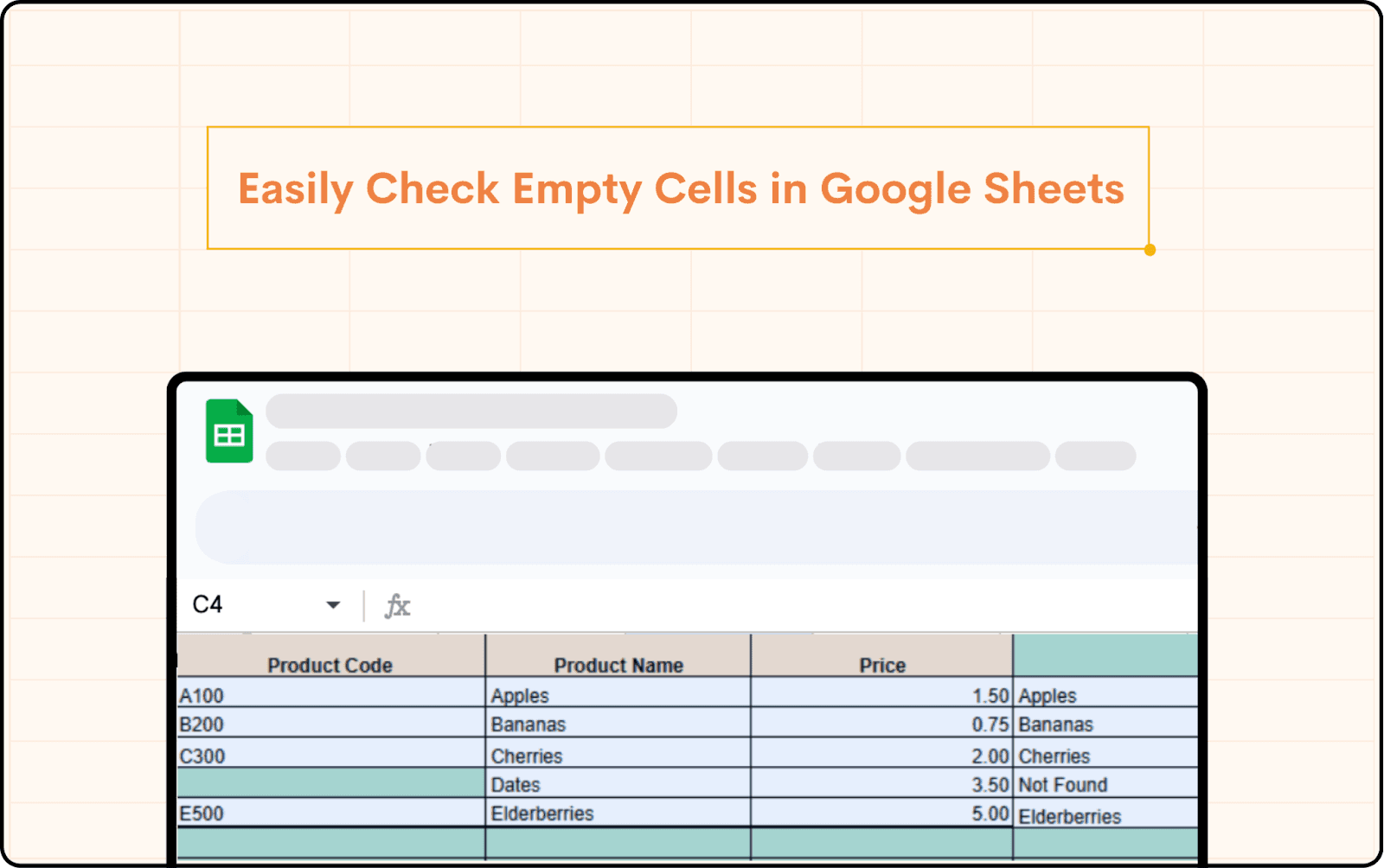Google Sheets Tutorial
How to Make a Checklist in Google Sheets
Learn how to make a checklist in Google Sheets with multiple methods. Discover easy solutions and tips to streamline your work.
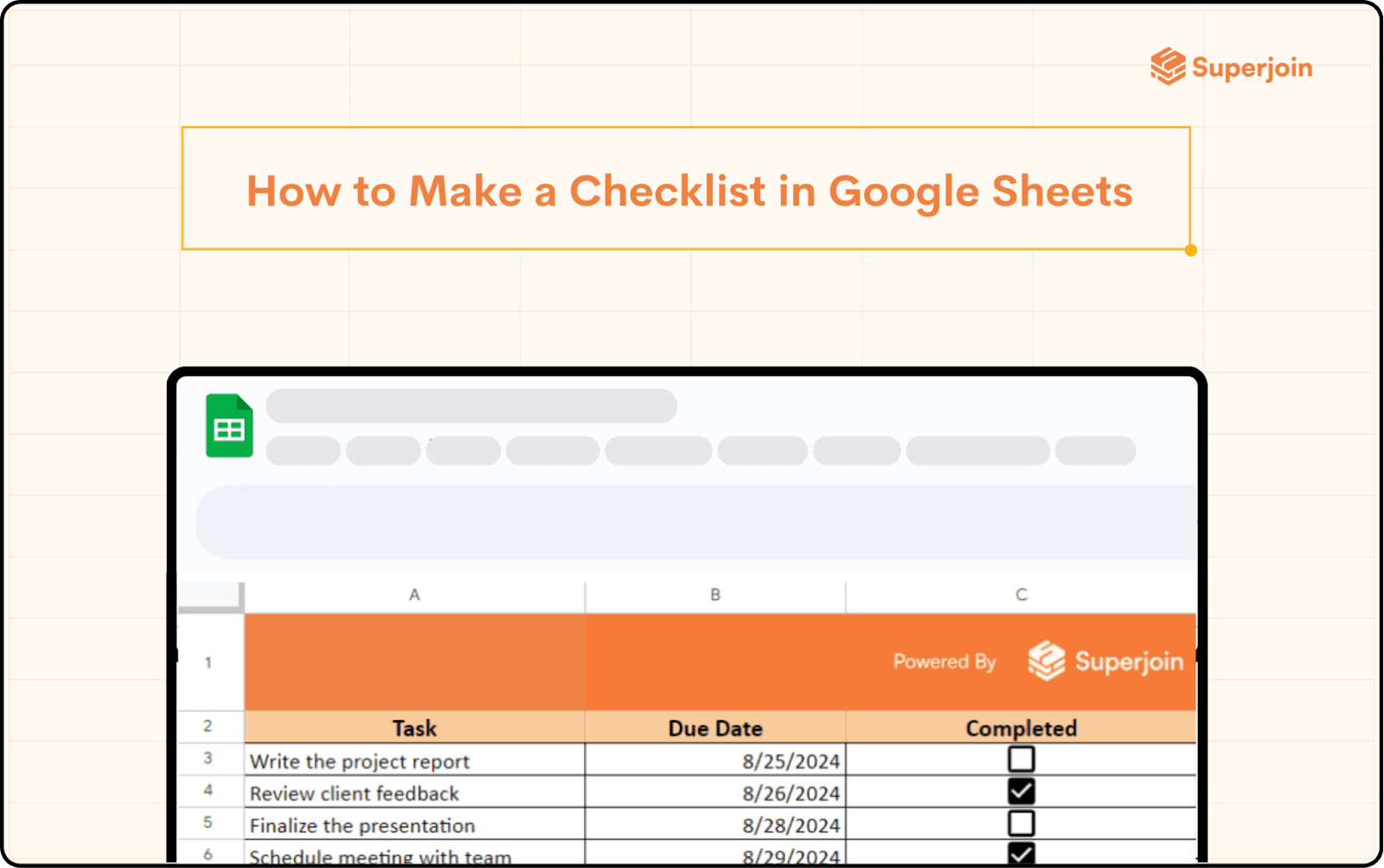


Nothing can be more effective at keeping you organized for tasks, managing projects, or tracking goals than a simple checklist. If you're already familiar with spreadsheets, then you have wondered how to make a checklist in Google Sheets. It is much easier than you might have thought, and it can be done in more than one way, thus offering you the flexibility to choose what will work best for you. Let's dive into the steps!
Why Use a Checklist in Google Sheets?
A checklist brings structure into the workflow of tasks and thereby keeps tabs on what's completed, and what needs attention. Be it daily tasks, projects, or a collaborative system of work—checklist Google Sheets will help with its real-time updates and a collaborative environment that easily organises.
But why would you use Google Sheets? It's free, it lives in the cloud, versatile. You can share it with your team and then get access on any device, even automate parts of your workflow. Thus, be it vacation planning, handling a project, or personal goal setting, Google Sheets is a perfect tool to get the job done.
Using Checkboxes in Google Sheets
This is probably the simplest and most effective way to make a checklist in Google Sheets. The checkbox feature gives you an intuitive and easy-to-use system to track your tasks. This further helps counting checkboxes since it is valued at 1 or 0 or to say ‘True’ or ‘False’ respectively.
Open Your Sheet: First, open a new or existing Google Sheets document. Decide where you want your checklist to be, such as in a new column.
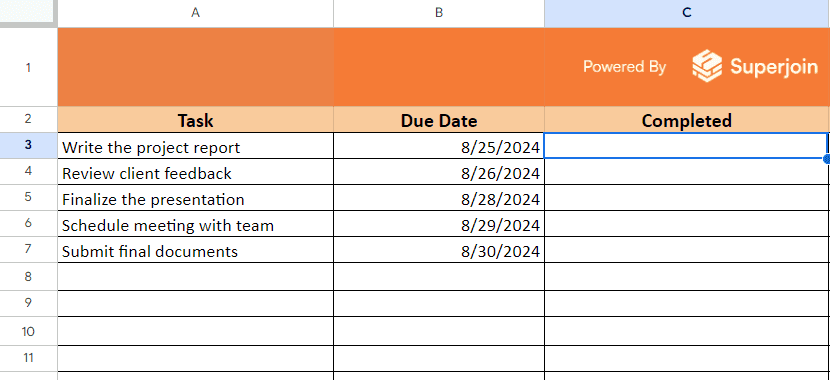
Select the Range: Highlight the cells where you want your checkboxes to appear. For example, if your tasks are in column A, and the due date is in column B, then highlight column B for the checkboxes.
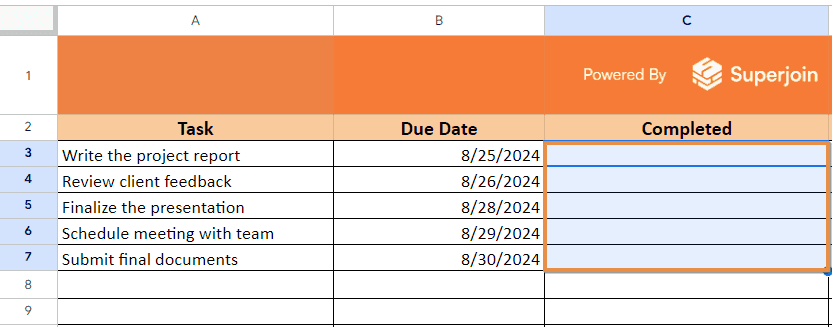
Insert Checkboxes: Go to the menu and click on "Insert," then choose "Checkbox." This will insert a checkbox in the selected cells. Now, whenever you complete a task, simply check the box.

The checkboxes will be added.
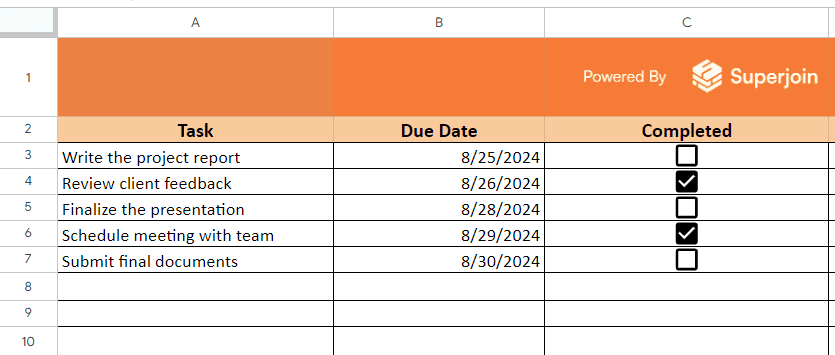
Format Your Checklist
To make your checklist more user-friendly, consider adding some formatting:
Conditional Formatting: You can automatically change the appearance of the row when a task is marked as complete. For instance, you can cross out or change the color of the text.
Highlight the task list (column A) and go to Format > Conditional Formatting.

In the format rules, select Custom Formula and enter the formula: =C1:C7=TRUE (adjust for your cell).
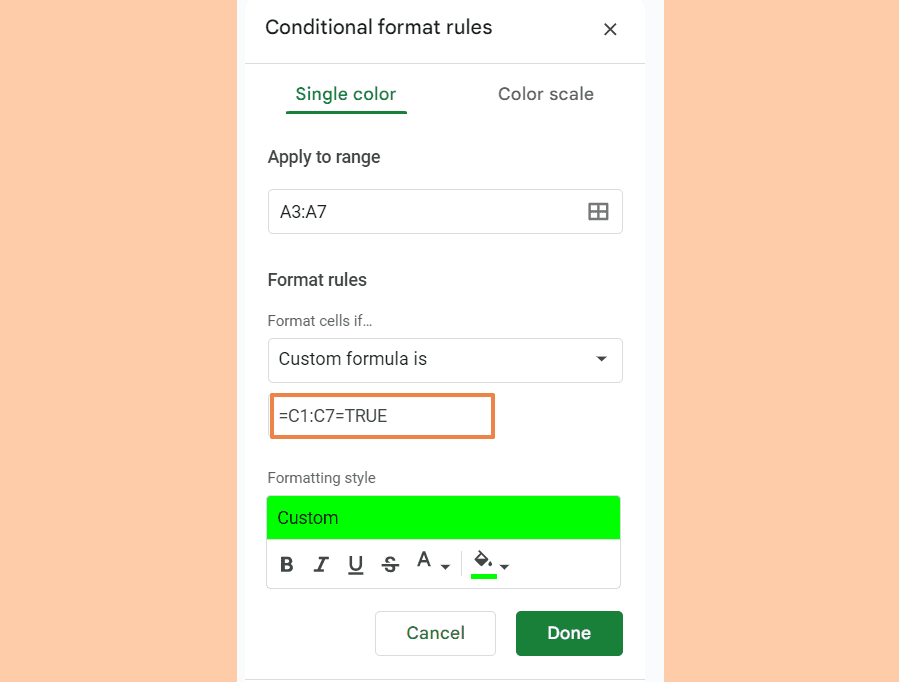
Choose your preferred formatting style, such as strikethrough or a color change.
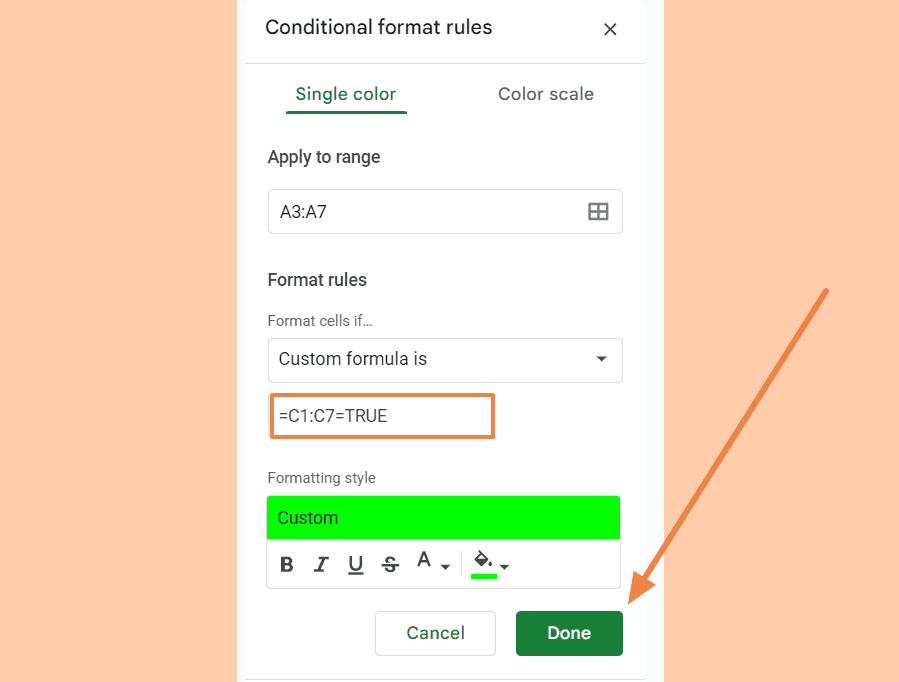
Now, every time you check an item, your task will automatically update its format, making it easier to track your progress!
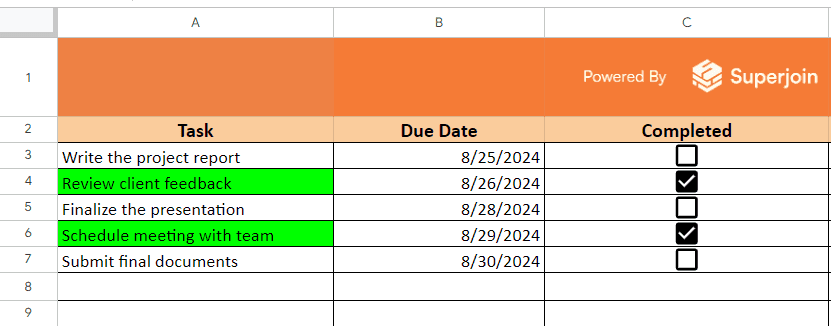
Use Superjoin's AI Formula Generator to Generate Formulas
Superjoin's AI Formula Builder uses advanced AI like GPT to generate formulas automatically based on simple prompts. This cutting-edge approach will likely become more popular as AI capabilities improve.
Automate Your Checklist
One of the best things about Google Sheets checklists is that you can automate them using formulas and scripts. For example, you can calculate the percentage of tasks completed or trigger automatic emails when a specific task is checked off.
To calculate the completion rate:
Use a formula like =COUNTIF(C2:B, TRUE)/COUNTA(A2:A) in a separate cell to find the percentage of tasks completed.

The percentage of tasks completed (or checked) will be updated.
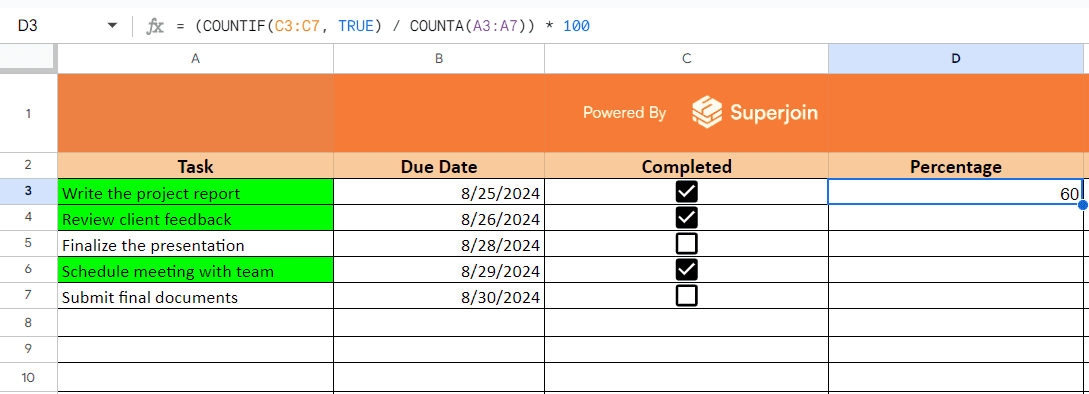
This small but powerful formula can give you a clear snapshot of your progress at a glance.
Conclusion
Making a checklist in Google Sheets is not only very easy but also highly flexible. Be it checkboxes, data validation, or conditional formatting—you pick what works best for you. The best thing about Google Sheets is its flexibility. Checklists can be used for personal projects and professional purposes to make sure your workflow is organised, efficient, and clear.
Now, practice these methods and create a checklist for yourself in Google Sheets. Whichever method you choose, you will find that task management has never been done better.
Say Goodbye to Tedious Data Exports! 🚀
Are you tired of the hassle of manually moving data from various tools into Google Sheets? Superjoin has a solution for you.
Superjoin is a Google Sheets add-on that automatically connects your favourite SaaS tools to your spreadsheets. It pulls data directly into Google Sheets, allowing you to create reports that update themselves without any manual work on your part.
Nothing can be more effective at keeping you organized for tasks, managing projects, or tracking goals than a simple checklist. If you're already familiar with spreadsheets, then you have wondered how to make a checklist in Google Sheets. It is much easier than you might have thought, and it can be done in more than one way, thus offering you the flexibility to choose what will work best for you. Let's dive into the steps!
Why Use a Checklist in Google Sheets?
A checklist brings structure into the workflow of tasks and thereby keeps tabs on what's completed, and what needs attention. Be it daily tasks, projects, or a collaborative system of work—checklist Google Sheets will help with its real-time updates and a collaborative environment that easily organises.
But why would you use Google Sheets? It's free, it lives in the cloud, versatile. You can share it with your team and then get access on any device, even automate parts of your workflow. Thus, be it vacation planning, handling a project, or personal goal setting, Google Sheets is a perfect tool to get the job done.
Using Checkboxes in Google Sheets
This is probably the simplest and most effective way to make a checklist in Google Sheets. The checkbox feature gives you an intuitive and easy-to-use system to track your tasks. This further helps counting checkboxes since it is valued at 1 or 0 or to say ‘True’ or ‘False’ respectively.
Open Your Sheet: First, open a new or existing Google Sheets document. Decide where you want your checklist to be, such as in a new column.

Select the Range: Highlight the cells where you want your checkboxes to appear. For example, if your tasks are in column A, and the due date is in column B, then highlight column B for the checkboxes.

Insert Checkboxes: Go to the menu and click on "Insert," then choose "Checkbox." This will insert a checkbox in the selected cells. Now, whenever you complete a task, simply check the box.

The checkboxes will be added.

Format Your Checklist
To make your checklist more user-friendly, consider adding some formatting:
Conditional Formatting: You can automatically change the appearance of the row when a task is marked as complete. For instance, you can cross out or change the color of the text.
Highlight the task list (column A) and go to Format > Conditional Formatting.

In the format rules, select Custom Formula and enter the formula: =C1:C7=TRUE (adjust for your cell).

Choose your preferred formatting style, such as strikethrough or a color change.

Now, every time you check an item, your task will automatically update its format, making it easier to track your progress!

Use Superjoin's AI Formula Generator to Generate Formulas
Superjoin's AI Formula Builder uses advanced AI like GPT to generate formulas automatically based on simple prompts. This cutting-edge approach will likely become more popular as AI capabilities improve.
Automate Your Checklist
One of the best things about Google Sheets checklists is that you can automate them using formulas and scripts. For example, you can calculate the percentage of tasks completed or trigger automatic emails when a specific task is checked off.
To calculate the completion rate:
Use a formula like =COUNTIF(C2:B, TRUE)/COUNTA(A2:A) in a separate cell to find the percentage of tasks completed.

The percentage of tasks completed (or checked) will be updated.

This small but powerful formula can give you a clear snapshot of your progress at a glance.
Conclusion
Making a checklist in Google Sheets is not only very easy but also highly flexible. Be it checkboxes, data validation, or conditional formatting—you pick what works best for you. The best thing about Google Sheets is its flexibility. Checklists can be used for personal projects and professional purposes to make sure your workflow is organised, efficient, and clear.
Now, practice these methods and create a checklist for yourself in Google Sheets. Whichever method you choose, you will find that task management has never been done better.
Say Goodbye to Tedious Data Exports! 🚀
Are you tired of the hassle of manually moving data from various tools into Google Sheets? Superjoin has a solution for you.
Superjoin is a Google Sheets add-on that automatically connects your favourite SaaS tools to your spreadsheets. It pulls data directly into Google Sheets, allowing you to create reports that update themselves without any manual work on your part.
FAQs
Can I share my Google Sheets checklist with others?
Can I share my Google Sheets checklist with others?
How do I automatically mark tasks as complete in Google Sheets?
How do I automatically mark tasks as complete in Google Sheets?
Can I add checkboxes across multiple sheets in the same Google Sheets file?
Can I add checkboxes across multiple sheets in the same Google Sheets file?
Automatic Data Pulls
Visual Data Preview
Set Alerts
other related blogs
Try it now

